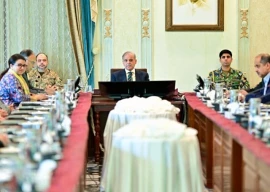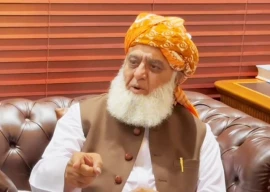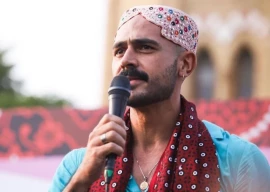
“The oldest living city” is how Peshawarites often describe it. Standing on Balahisar Fort, the sense of history breaking and rebuilding itself in Peshawar is as tangible as the rough, red bricks which now hold the fort and its ancient tales within.
Quite like current times, the city itself has been the one force which all conquerors have sought to tame – a gateway to Central Asia, so to speak. The fort has seen the dust settle and has re-emerged from fires with different plumage but always a citadel.
It is said the Marathas passed it on to the Abdali forces after which it was passed on to Ranjit Singh, under whose rule it was razed down and rebuilt. According to historian Ahmad Hassan Dani, the British then replaced the outer mud walls with brick work.

The inside of the fort today obviously does not retain the gilt-edged pomp, which Major General Elphinstone narrated in 1809, as quoted by Dani in Peshawar, historic city of the frontier, 1994. It retains the past in its tightly bound corridors, parapets and rooms. PHOTOS: HALIMA MANSOOR/EXPRESS
The Frontier Corps (FC) has inhabited the fort since 1948. The FC was raised from the tribal belt under the British rule with the Khyber Jezailchis – now Khyber Rifles – emerging as the first of several such forces. Viceroy Lord Curzon placed the FC Headquarters (HQ) as Balahisar Fort in 1948, where it has remained since.
However, the Khyber-Pakhtunkhwa (K-P) Assembly recently passed a unanimous resolution asking the FC to handover the historical fort to the civil administration so it can be open to the public.

The inside of the fort today obviously does not retain the gilt-edged pomp, which Major General Elphinstone narrated in 1809, as quoted by Dani in Peshawar, historic city of the frontier, 1994. It retains the past in its tightly bound corridors, parapets and rooms. PHOTOS: HALIMA MANSOOR/EXPRESS
The inside of the fort today obviously does not retain the gilt-edged pomp, which Major General Elphinstone narrated in 1809, as quoted by Dani in Peshawar, historic city of the frontier, 1994. It retains the past in its tightly bound corridors, parapets and rooms. There is a shiny museum inside, unfurling the history of the FC on suffocating walls, in glass cages and honouring its fallen in neat rows of frames. The darker bowels of Balahisar remain out of view.
As a part of history, it merits to be owned by the public. Or so the resolution suggests. Presented by MPA Syed Ishtiaq Urmar, it was passed unanimously, and perhaps will end up fulfilling Pakistan Tehreek-e-Insaf Chairman Imran Khan’s claim that the fort will made accessible to all.

The inside of the fort today obviously does not retain the gilt-edged pomp, which Major General Elphinstone narrated in 1809, as quoted by Dani in Peshawar, historic city of the frontier, 1994. It retains the past in its tightly bound corridors, parapets and rooms. PHOTOS: HALIMA MANSOOR/EXPRESS
This effort was not begotten by PTI alone – for many years, the provincial government has tried to relocate the FC Headquarters in order to cut Balahisar Fort loose from its current secrecy. But those efforts have not gained much ground. Sources told The Express Tribune the handing over of Balahisar to a civilian government started in 1990s. The then NWFP government allocated “432 kanals of land” to the FC to shift its HQ.
The tussle
In 1997, the then chief minister Sardar Mehtab Abbasi visited the under-construction HQ in Hayatabad and issued a written directive, stating an “additional Rs10 million would be released for [the HQ’s] completion and within six months the fort will be opened.” Unfortunately, the order remains unimplemented to this day. However, the structure of the HQ does exist in Hayatabad, an area close to Khyber Agency.
Back in the 1990s, the provincial secretary had informed his federal counterpart that Balahisar was not notified as a “national monument” and sought funds for its conservation. He also asked to bring Qilla Balahisar under the ambit of the Antiquities Act of 1975.

The centre was also informed of the FC’s concerns over the deteriorating condition of the fort – a concern which the paramilitary outfit had conveyed to the provincial government. This communiqué suggested the fort could be made accessible to tourists if higher authorities permitted.
From all these discussions, it was clear there was a lack of funds for the upkeep of the qilla. The province continued to ask authorities to take note and implement the Antiquities Act 1975 so Balahisar could be preserved. The fort, however, was not declared an antiquity under the relevant federal act or, after the 18th Amendment, under the NWFP Antiquity Act 1997 through the ineffective Khyber-Pakhtunkhwa (K-P) Directorate of Archaeology & Museums.
Considering some claim Balahisar Fort is as old as 2,000 years, it does seem an example of shoddy performance on behalf of the department that the structure is yet to be granted heritage status or be included in the Protected National Monuments list.
Experts have also shown considerable concern over handing the fort over to a civil administration – they say once in the hands of the province, the condition of Balahisar can further deteriorate.
Cultural Heritage Council’s Dr Ali Jan, a conservationist, told The Express Tribune, “This argument carries some weight given the poor performance of government departments.” Jan has also produced a video of the fort, which is featured on the blog Qissa Khwani’s Facebook page.

Jan recommended the fort should first be declared and notified as a protected national monument and brought under the provincial Antiquity Act.
The K-P government has to create an autonomous authority, Jan suggested, labelling it the ‘Forts, Horticulture, Gardens, Parks & Recreational Places Authority, Peshawar’. This should assume control of the fort and all such public places to manage them appropriately. According to the conservationist, under said authority, all properties would have to follow a set of rules and bylaws so they are managed according to acceptable standards.
Jan also criticised authorities looking over Balahisar for constructing new structures inside the fort. Even the repair work has not been in line with conservation standards, he noted. Snuggled between high-rises and flyovers, not much can protect the fort from environmental wear, and erosion.
Edited by Halima Mansoor
Published in The Express Tribune, January 31st, 2014.


















COMMENTS
Comments are moderated and generally will be posted if they are on-topic and not abusive.
For more information, please see our Comments FAQ